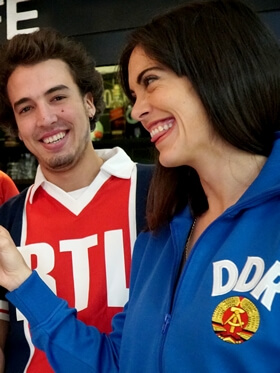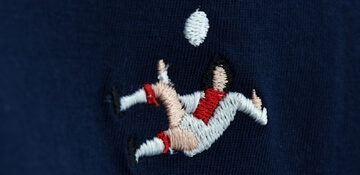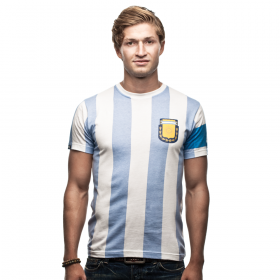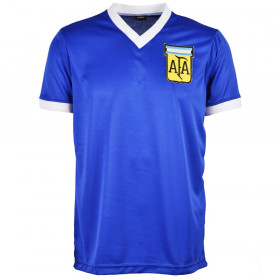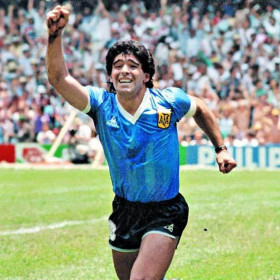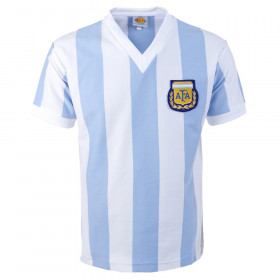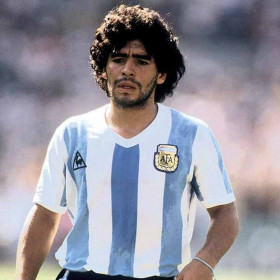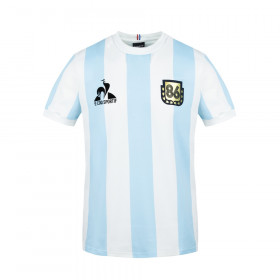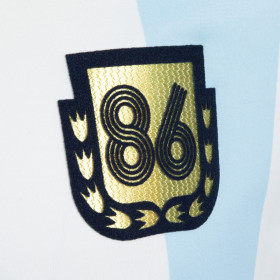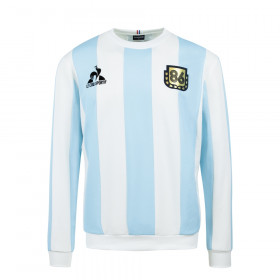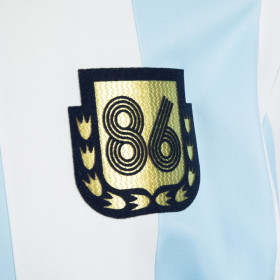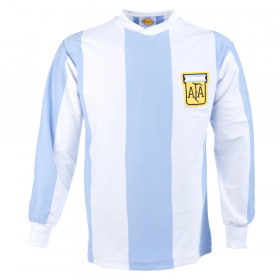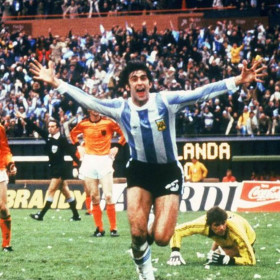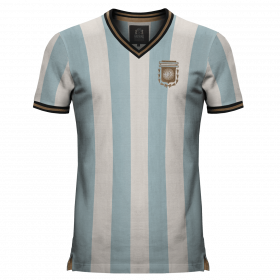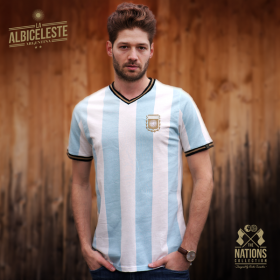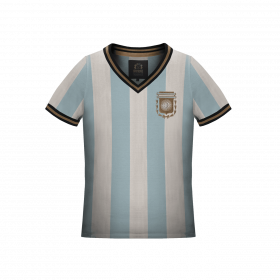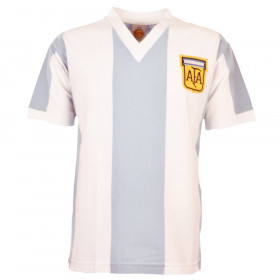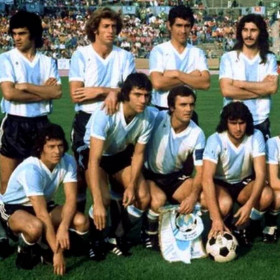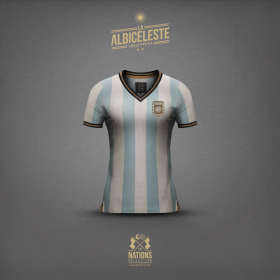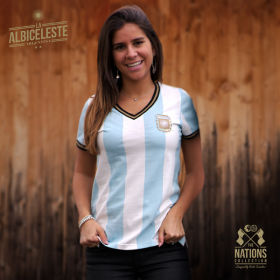Argentina Retro Shirts

-
Argentina Capitano T-Shirt
£36.91 -
Argentina 1982 Retro Shirt
£55.39 -
Argentina Classic Shirt 1978
£55.39 -
Argentina | La Albiceste
£46.11 -
Argentina 1974 Retro Shirt
£55.39
We present you the collection of Retro football jerseys of the national team of Argentina, one of the most popular and rewarded teams of the American continent; the Albiceleste have won the World Cup twice, notably in 1978 and in 1986 and hold the second place in the ranking of wins in the Copa America. In addition, the legendary skills and the strong personality of its players, make them one of the best of all time, such as Diego Armando Maradona in the past or Messi today and the passion of the Argentinian football fans make this team one of the most followed on the planet.
Among others you will find the following retro football jerseys:
Retro Shirt Argentina 1978, World Champions:In 1978 the World Cup was played in Argentina the country is ecstatic because of the popularity of football in Argentina and the passion with which the king of sports is followed in the country. Under the direction of Menotti and with the participation of famous players such as Kempes, Bertoni or Passarella the Argentineans won the trophy in the final, 3-1, against Holland Neeskens and Krol. It was a dream victory for Argentinian football.
Argentina 1982 Retro Jersey: At the 1982 World Cup, Menotti's Argentina team reached the second group stage. The team could not win the matches against the future champion Italy, and Brazil. The Albiceste team had an excellent selection: Diego Armando Maradona, Mario Kempes, Valdano, Passarella and the defender of Florence, Bertoni. The Argentina jersey of 1982 is nevertheless one of the most elegant of the albiceleste, a must-have.
Argentina World Champion 1986 Retro Shirt: the legendary 86 albiceleste jersey, that witnessed great moments in the history of football. There is the best performance of Maradona in the tournament the quarterfinals against England where he scored his historic double; the goal of God's hand and the best dribbling in the history of the World Cup. Valdano, Burruchaga and goalkeeper Pumpido accompanied the Argentinian star in an adventure that ended with a victory in the final against Rumenigges Germany.
Retro football shirts of Argentina. A remarkable timeline through the events if Argentinian for enthusiasts of the King of Sports in South America. Retro fashion for Men and Women with style!
ARGENTINA NATIONAL FOOTBALL TEAM: FOOTBALL SHIRTS AND HISTORY
Argentina national football team, one of the most successful in South America and in the world, would be unrecognizable without its iconic jersey. This shirt with light blue and white stripes was worn by the two great football legends: Diego Maradona and Lionel Messi.
The beginning of the Argentina national team
The AFA, Argentina Football Association, founded in 1893 by Scotsman Alexander Watson Hutton, is the oldest of all the football associations in South America. Their first game was in Montevideo in 1901 against the Uruguayan national team; Argentina won 3-2. The Argentines played with a white kit. It was only in 1908, at the Newton Cup, that the light blue and white striped shirt "la Albiceleste" made its debut. Since then, it has been used almost exclusively by the national team, with very few exceptions.
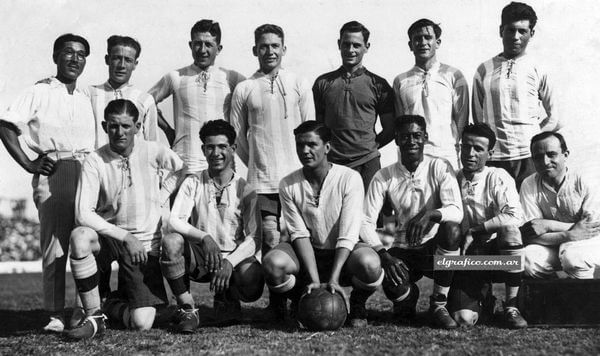
The Argentina national Team in 1925
The first two World Cups
Argentina was one of the favorites to win the World Cup in 1930, and their forward Guillermo Stabile, from the Argentine club Huracán, was in great shape. A victory over France in a controversial and energetic match, followed by victories over Mexico and Chile with five Stabile goals, leads them to a semi-final against the United States. The North Americans scored a goal in the last minute, but the Argentine's six goals before that lead them to the final. It is estimated that between ten and fifteen thousand Argentine spectators tried to watch the match, but there were not enough boats, and therefore many Argentines could not even go to Montevideo to watch the final match. Unfortunately for those who succeeded, the result was disappointing: 4-2 for Uruguay.
In 1934, there were only four teams outside of Europe among the sixteen teams participating in the World Cup in Italy. Uruguay refuses to participate, and Chile and Peru withdraw, so Argentina and Brazil qualify without even playing a game. There were internal disputes in the Argentine team so that no player who had played in the last four previous years participated in this Italian World Cup. The matches are knockout matches, and Sweden after losing during the match twice managed to come back, the second time after a 1-2 they managed to defeat the Argentines 3-2.
Lack of success in several World Cups
The Argentine national football team did not participate in the World Cup in France in 1938, nor in Brazil's 1950 or in Switzerland in 1954, due to disagreements with FIFA and the Brazilian Football Federation for the World Cups of 1938 and 1950. They did not attend the 1954 football World Cup due to a political decision either. However they were victorious in the Copa América in 1937, 1941, 1945, 1946, 1947, 1955 and 1957. The coach of all these victorious Argentine teams on the American Continent was his former star scorer, Guillermo Stabile. The 1957 team was the most notable of this period, with players like Oreste Corbatta, Humberto Maschio, and Antonio Angelillo capturing the imagination of South America with their technical and artistic play.
But in 1958 for the World Cup in Sweden, Maschio, Angellilo and Sivori were not selected by Stabile, and despite a victory against Northern Ireland, two defeats against West Germany and Czechoslovakia (with a score of 6-1) leads to the elimination of the Albiceleste team. For the match against Germany as the German team wore a white jersey, the referee before the match said that the colors were not distinguished on the field so the Argentines, who did not have replacement jerseys, had to get hold of the yellow jerseys from a local team, IKF Malmö. Wearing the color of their Brazilian rival did not bring them good fortune and they lost 1-3. In addition to these bad results, supposedly, 10,000 Argentines waited for the arrival of the players to Buenos Aire to insult them. This World Cup remains for the history of Argentine football as "The Swedish disaster".
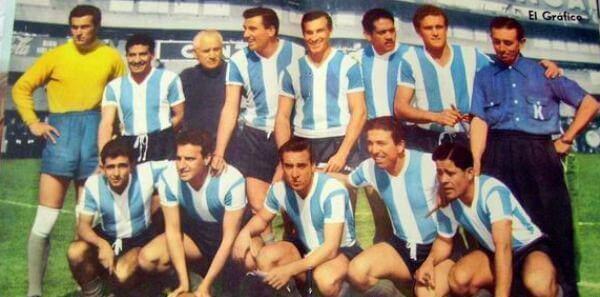
Argentina national Team in 1958 World Cup in Sweden
At the 1962 World Cup in Chile, the story is just as disappointing: a victory, a draw and a defeat are not enough and Argentina returns from Chile with a strong lack of success. At the 1966 World Cup, hosted by England, the nation where football was invented, the Argentine intervention was slightly better. Two wins and a draw in the group stage lead to the quarter-finals against the hosts. This match was very fiery, and the Argentines felt favoritism towards the English by the referee. Antonio Rattin, who protests to the referee is sent off from the game for his look at the referee, which this latest took it as an insult. This was recognized the German referee Rudolf Kreitlein. And all this despite the fact that the referee did not speak a single word of Spanish. In protest, Rattin sat on the red carpet destined for Queen of England Elizabeth II and had to be escorted from the pitch by two policemen. This is a very important incident in the history of football, because the invention of the yellow and red cards was derived from this match since Rattin, not understanding the referee, did not feel sent off. In this way, an incident of alleged lack of understanding between the referee and the players would be avoided in the future. These cards were part of the refereeing on the next World Cup. The Argentine team does not even qualify for the 1970 World Cup in Mexico, the only time in its history and one of the most humiliating events for Argentine football.
Qualifications for the 1974 World Cup are not easy either. In the match in Bolivia, at La Paz capital there was concern about the altitude. The Argentine team, which won by 1 goal to 0, is nicknamed "La Selección Fantasma", because there was very little information from the media. Kempes even said that the Argentine team had to play to raise money for food because the AFA, the Argentine Football Association had forgotten them! They qualified anyway, but again the Albiceleste's performance was disappointing. They reached the second round, but lose against Brazil and the Netherlands. A draw against East Germany eliminated them.
In our selection of shirts you can see the Argentina 1974 retro shirt with a large blue stripe in the center, a v-neck; minimalist and very beautiful.
The 1978 triumph
Argentina hosted the 1978 World Cup in its stadiums among them "el Estadio Monumental" and "José Amalfitani Stadium". This tournament was somewhat controversial and the performance of the Argentinians team was somewhat blurred by other circumstances. All games were supposed to be played at either 1:45 pm or 4:15 pm. But for no reason, the Argentina team decided to play their matches at 7.15pm. This, which at first seems harmless, benefited the Albicelestes. We will see how; After Brazil and Argentina are both second in their group stage of their respective groups and in the next round they fall into the same group. The group winner had to be played on goal difference. Brazil then faces Poland and wants to play at the same time as Argentina but they played at 4:45 pm and Argentina and Peru did so at 7:15 pm. With this time difference, the Argentine team knew that to go to the final they had to win by a difference of 4 goals against the Peruvian team. The Albiceleste won by a resounding 6 to 0 to the Peruvian team.
Furthermore, the Netherlands team, after losing the final match against Argentina, refuses to go to the post-match ceremony due to Argentina's lack of fair play.
But not all were incidents and disagreements. There were, of course, glorious moments of Argentine football. Mario Kempes becomes one of only three players in history to win the World Cup, the title of top scorer and the title of best player with Garrincha and Paolo Rossi. He scored a brace in three games, including the final against the Netherlands, where he scored a goal in the first half and another in overtime. In the group stage, he touched the ball with his hand and gave a penalty to Peru. Another star of the team, Ubaldo Fillol, the goalkeeper saved the penalty kick. This goalkeeper is considered the best Argentine goalkeeper and one of the best goalkeepers of all time. In this World Cup, he wears the number 5 instead of the number 1. The Argentine goalkeeper wears a green shirt with a white collar and black shorts, he is called 'El Pato', and is chosen as the best goalkeeper in this World Cup.
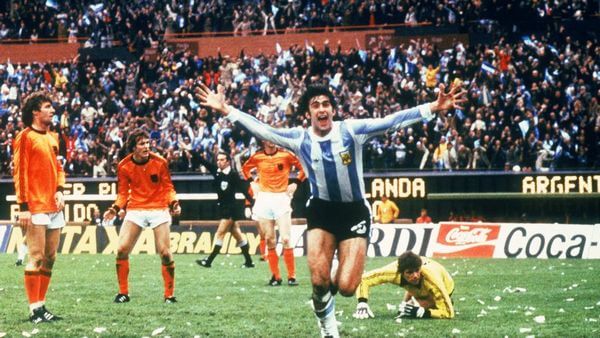
Mario Kempes, the hero of the 1978 World Cup in Argentina
You can see the replica of the Argentina Classic Shirt 1978 in our selection of shirts above. The best replicas of the highest quality for all fans of Argentine football.
A disappointing World Cup
Although he almost played the 1978 World Cup, 1982 was actually the year Diego Armando Maradona made his World Cup debut. Other notable players for this Argentine team were Osvaldo Ardiles, one of only three players on the team who did not play on an Argentine club, and captain Daniel Passarella. Unfortunately, a loss against Belgium and victories against Hungary and El Salvador brought Argentina into the group of death in the next round. Maradona is only 21 years old and La Albiceleste did not yet have the answers to stop Paolo Rossi's Italian team on the one hand and Zico and Socrates's Brazil team. They lose their two games and are eliminated from the Spanish World Cup, much to the disappointment of the Argentine soccer fans.
Above you can see the Argentina 1982 Retro Shirt, the shirt worn by Diego Armando Maradona's debut in a World Cup. In the product file we recommend that you click to see the vintage photo with a very young Maradona proudly wearing the shirt of his country.
A second world victory for Argentina
At the 1986 World Cup in Mexico, there was a lot of excitement from the Argentine fans, for one reason in particular: Diego Armando Maradona. At 25, he is near the peak of his potential, and this World Cup was truly his. The quarter-finals against England are a true symbol of Maradona: his first goal is sublime, he dribbles player after player until he also dribbles the goalkeeper and scores the historic goal. His second goal, however, is not so sublime, but it is as beloved or more by the Argentines. Maradona and Shilton jump together to get to the ball, but the Argentine arrives first because he uses his hand instead of his head. The referees do not whistle, and Argentina eliminates England with a score of 2-1. When the star Maradona is asked after the game, he says that it is not his hand, but the hand of God. In the semi-finals, he scored two goals against Belgium. And already in the final against West Germany it was Maradona who assisted Burrachaga so that the third goal entered the net to end up winning 3-2. The Germans had seen the danger that Maradona represented and Lohar Matthaus tried to individually tag him, but it was not enough.
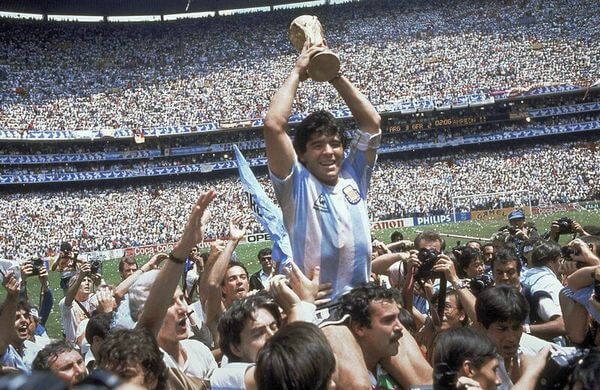
Diego Maradona, Argentina World Champion in Mexico 1986
We invite you to browse above in our selection of La Albiceleste shirts the Classic shirt Argentina 1986. You can see the iconic image of Maradona lifting the trophy on the playing field. The shirt is very beautiful, with a round neckline, short sleeves and the characteristic smaller light blue and white bands. A must for Maradona football lovers.
The Argentina football team in the 1990s
The 1990 World Cup in Italy saw another impressive performance from the Argentinians. The players will push their game to reach the final against West Germany, after leaving behind Brazil, Yugoslavia and Italy in the round of 16, quarter and semi-finals respectively. However they were loaded with red cards and after a penalty converted by Brahme in the last minute of the final match, the dream of becoming champions again fades away. The Albiceleste fans will have to settle for second place.
For the occasion, the players wear Adidas brand shirts, with thinner stripes than before and a v-neck.
The victory as semifinalists is the last great triumph of Diego Armando Maradona with Argentina, unfortunately, because in the 1994 World Cup in the United States he tested positive for ephedrine. Team morale will suffer, and the Romanian team, with Hagi as the flag, take them ahead in the round of 16 match with a score of 3-2. According to Maradona this team was the best XI of all time; Cholo Simeone, Batistuta, Maradona, Luis Islas, Fernando Cáceres, Ariel Ortega, Abel Balbo, Ruggeri among others.
Likewise for the 1998 soccer World Cup in France, they will fall in the quarterfinals despite the great performance of Roberto Ayala, the goalkeeper.
Three difficult World Cups
In 2002 at the World Cup in Japan and South Korea, Argentina fell in the group stage, at great disappointment for the Albicelestes fans.
In 2006, at the World Cup in Germany, Argentina finished first in the group stage and eliminated Mexico in the second round 2-1, and became one of the five teams to score more than one, but fell in the quarterfinals against Germany that eliminated them in the penalty round with Esteban Cambiasso, who missed the last shot of the penalty shootout for Argentina.
Even though Lionel Messi is playing well during the 2006 and 2010 World Cups, it is not enough to carry Argentina beyond the quarterfinals. In the 2010 World Cup in South Africa, Germany leads the Argentine team by an overwhelming 4-0 in the quarterfinals and with Messi almost invisible during the match.
The 2014 and 2018 World Cups: The 2014 World Cup is the most disappointing for Messi, and for the Argentine fans in general as the team is second after losing the final against Germany, one of their eternal rivals. They had an extremely strong team defensively and not very creative offensively. But with 1 goal conceded and 0 scored in the final, they have to return home without achieving the dream of winning a World Cup with Messi.
In 2018, they were eliminated by the French team. In a very eventful match, France emerged victorious 3-2. At the 2021 Copa América in Argentina and Colombia, Argentina will hope to take its 15th title.
All these comings and goings cannot make us forget that the Argentine football team won the World Cup twice, in 1978 and 1986, and has played three finals; in 1930, 1990 and 2014, and that the Albiceleste also won the Copa América fourteen times and has also obtained two Olympic gold medals.
If we say that on certain occasions some World Cups are disappointing it is because of this splendid record and because of the demands that are always granted and deserved by the great teams of world football. And certainly Argentina is one of them. These mythical shirts with the symbolic white and blue stripes represent the passion for soccer of this great nation of the beautiful game.
 Retrofootball
Retrofootball  Belgium
Belgium  France
France  Germany
Germany  Italy
Italy  Portugal
Portugal  Spain
Spain  Switzerland
Switzerland  United Kingdom
United Kingdom  other countries
other countries  Retrorugby
Retrorugby 
